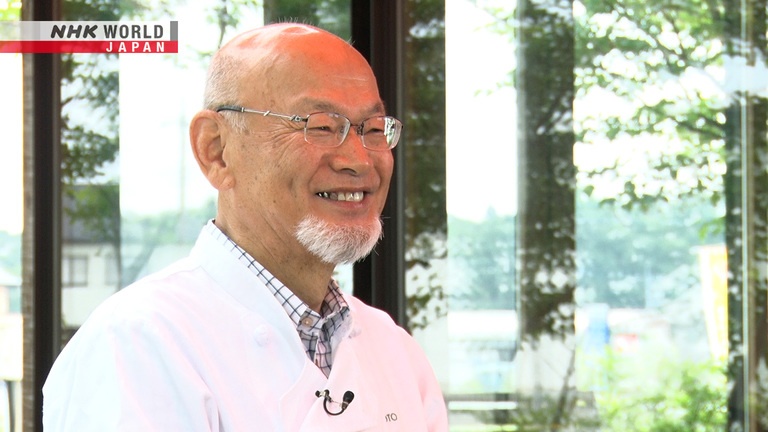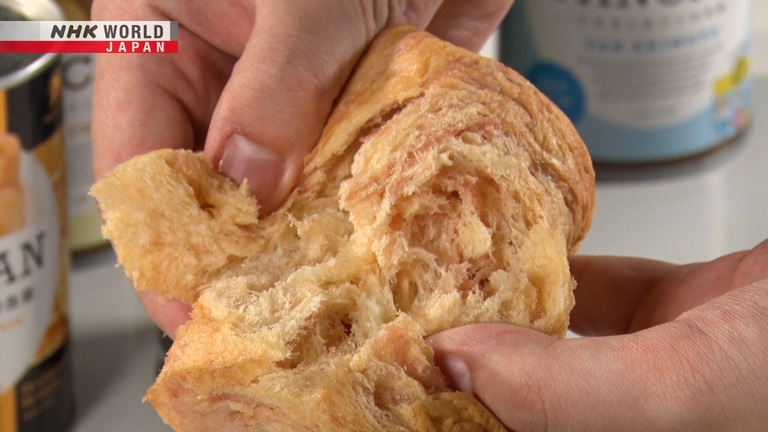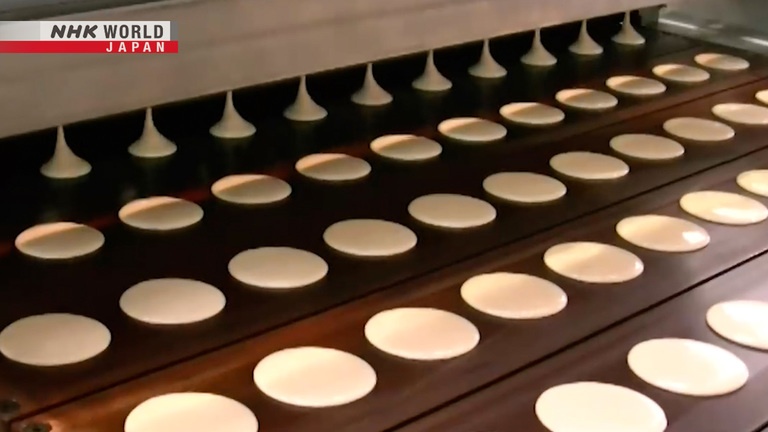Canned Bread / Automatic Dorayaki Machines
The fascinating stories and secrets behind hit Japanese products, plus parts and machines that boast the top share of niche markets. In the first half: the story behind canned bread developed by a Japanese bakery in 1996 which doesn't go stale easily and has a long shelf-life. In the second half: a machine that makes dorayaki, a Japanese sweet with red bean paste sandwiched by pancakes. We introduce this unique machine that's also being used to make other sandwich pancakes around the world.



Transcript
"Japan's Top Inventions"
The behind-the-scenes tales of hit products and creations from Japan.
This is "Japan's Top Inventions."
On today's show,
canned bread that's soft and lasts long.
It was sent to Ukrainians as an emergency food supply.
We share the secret of how it was made.
Later on the show:
"dorayaki," a popular Japanese sweet.
We introduce a unique machine that can make local variations of this tasty treat!
Hello, welcome to "Japan's Top Inventions."
I'm your host, Jason Danielson.
In the first half of our show, we take you "Behind the Creation."
Today's topic is this:
canned bread, developed by a Japanese baker in 1996.
Just pop it open and voila! A real piece of bread.
This canned bread has a shelf life of three years.
Over 300,000 cans have been donated
to disaster or famine-struck areas in 19 countries and regions around the world.
Development started after a large earthquake struck western Japan.
A bakery in Tochigi Prefecture.
Freshly baked bread!
Inside the store, a variety of freshly baked goods are on sale.
Over in this corner,
the bakery's original canned bread.
Blueberry, orange, strawberry.
There are nine flavors to choose from.
This was made two years ago.
If you give it a squeeze, it's still just as soft now.
Our story begins
back on January 17th, 1995.
A devastating 7.3-magnitude earthquake
struck Hyogo Prefecture in Western Japan.
Supplies from all over the country were delivered to Kobe,
one of the affected cities.
In Tochigi, far away from Kobe, a baker was hard at work.
His name, Akimoto Yoshihiko.
After the quake, he spent two days baking 2,000 pieces of bread
to send to the affected area.
I'm a baker.
I thought the only thing I can do to help is to make bread.
So I loaded up the bakery's one-and-a-half-ton truck with a lot of bread
and off it went.
The bakery's truck was sent to Kobe straight away.
The bread Akimoto made was to be given out for free.
But then, four days later.
Akimoto got a call from Kobe.
It wasn't what he expected to hear.
"The bread went bad before it could all be eaten."
They started by saying thanks,
but they had kept over half of the 2,000 pieces
for people coming the next day.
So after a day, two days, three days, the bread went bad.
It wasn't good to eat anymore.
At the time, a common emergency ration were these hard biscuits.
While they lasted long, they were tough to eat,
especially for those with weak teeth.
Akimoto was asked over the phone,
"Can you make something that lasts long but will also stay soft?"
They asked if there was something that kept like the biscuits, but soft.
I said, "No."
So then they asked whether I could make it.
Like, wasn't that my job as a baker? My mission?
The discussion went in that direction.
When I heard that, I was really motivated to challenge myself
and make this new bread.
And so, Akimoto dedicated himself
to creating a soft bread with a long shelf life.
He began cooking up a plan by himself at the bakery.
His first idea was to preserve the bread by vacuum-sealing it.
The bread was placed in a bag, and the machine would suck all the air out.
But vacuum-sealing compressed the bread.
When the pack was opened, the bread did not regain its shape.
I knew vacuum-sealing would squash the bread.
But there are those vacuum-sealed sponges, and those reinflate when opened,
but the bread doesn't.
Bread rises when it's made.
If you forcefully compress it, it stays flat.
Was there something other than vacuum-sealing?
Akimoto searched for days for inspiration.
He knew someone that worked at a food processing facility.
And they made a certain product.
Canned vegetables.
In order to preserve the vegetables, they were placed in cans
and then sealed with a special machine.
Could this device be used with bread?
Akimoto reached out to borrow the canning machine.
Fresh bread was placed inside a can,
and sealed by the machine.
Akimoto had high hopes that this would be the answer.
But then, three days later.
Akimoto opened up the can.
The bread inside had gone completely moldy.
It was moldy.
It even smelled.
Microbes in the air had gotten inside.
If you don't completely eliminate these airborne microbes, they multiply in there.
They have all they need inside the can to grow.
How to prevent the mold?
There was only one way:
put the dough in a sterilized can, bake it, and immediately seal it off.
But there was a problem.
No mold formed,
but the dough had stuck to the can, and the bread tore apart when removed.
Could this canned bread really be made?
Akimoto was struggling.
Development of the canned bread was facing one obstacle after another.
How could Akimoto prevent the bread from sticking to the can?
He decided to try using this paper here.
How did it go?
Let's find out!
Akimoto purchased some parchment paper used for baking.
It was non-stick and heat-resistant.
He lined the can with it.
A few days later.
Akimoto opened the can
and couldn't believe what he found inside.
The bread was wet.
I opened it up and I was shocked.
There was moisture between the can and the bread.
That bit got soggy.
This wouldn't be acceptable.
The reason was because the bread was sealed hot.
Condensation built inside the can as it cooled.
That moisture was making the bread wet.
The problem now was the condensation.
Akimoto searched far and wide for a solution.
He remembered something he'd learned about:
traditional Japanese shoji doors.
The special washi paper on the doors
can absorb moisture and help regulate humidity.
I have a friend that's a builder and architect.
They told me that Japanese-style rooms
are able to keep a consistent humidity level,
and that's because of the shoji doors.
That was how I learned they had that kind of function.
So, I wondered whether I could use that kind of washi paper.
Akimoto put the special washi paper in the can.
The results were promising,
but the condensation caused the paper to come apart.
Was there something similar, but more water-resistant?
Akimoto sourced various kinds of paper to try in the can.
After many trials, he found a special imported paper that held together
and prevented the bread from getting wet.
And so, in September of 1996,
over one and a half years after Akimoto had started,
the soft canned bread was finally realized.
One of the places Akimoto sold his canned bread to was a company's office.
The bread was intended for use as an emergency food supply.
He gradually built up a clientele.
However, two years after the bread was sold,
Akimoto received an unexpected phone call from one of the companies.
They asked me to dispose of the canned bread
that was nearing the "best before" date.
They would buy more to replace it.
Canned bread still has an expiry date,
so if it's not eaten in time, it'll be thrown out.
Being told to dispose of the bread
was almost like being told it hadn't been useful.
That was frustrating.
Then one day, there was a breaking story in the news.
In late 2004,
an earthquake struck off the coast of the island of Sumatra, in Indonesia.
A tsunami hit after the quake, and there was a food shortage.
Someone Akimoto knew asked him to send his canned bread to Sumatra.
The wife of that person taught at a Japanese school on Sumatra.
She knew about the canned bread through her husband.
Anything would help in this situation,
so if I had any unsold bread, I was told to please send it.
This event gave Akimoto an idea.
Instead of throwing out the older cans, he could find a new use for them.
The bread had a shelf life of three years.
When there was less than a year remaining,
he would send a request to his clients to return the unused cans.
New cans would be sold, and the old ones would be donated
to disaster or famine-struck areas through non-government organizations.
New cans go out and old cans come in all the time.
Old cans might end up being thrown out here in Japan,
so before they expire, we send them to a place that needs them.
Using this idea, Akimoto was able to send canned bread
to the area affected by the earthquake and tsunami.
Since then, over 300,000 cans of bread have been donated
to 19 countries and regions struck by famine or disaster.
In March 2022, the bread went to a new destination:
the people of Ukraine, who had been invaded by Russian troops.
Many Ukrainians fled to a shelter in neighboring Poland.
Akimoto immediately sent 200 retrieved cans there.
This is a clip of the shelter staff trying out the canned bread.
Very good.
The supplies from Japan were able to bring a bit of cheer during a difficult time.
And so, the canned bread has also been delivered to Ukrainian refugees.
What kind of impact has canned bread had in these emergency situations?
To find out more, we are joined by Kondo Takashi,
who helped get the canned bread into the hands of those Ukrainian refugees.
Welcome to the show.
Thank you.
How did the canned bread end up being given to Ukrainian refugees?
Our non-government organization is known as "Hunger Zero" in Japan
but overseas it's called "Food for the Hungry."
We deliver food to places around the world during emergency situations.
In the past, we worked with Akimoto-san to deliver canned bread
to places in Africa, Asia, and South America.
Since we had that relationship already,
we were able to deliver that initial supply of 200 cans,
like this one, to Ukrainians.
Can you tell us exactly when and where you delivered the canned bread?
There's a temporary shelter near the Ukrainian border in Poland,
where people fleeing the country can stay.
We were in Poland for about two weeks in March and April 2022.
Many Ukrainians were at the shelter.
We gave the canned bread to those people.
The volunteers at the shelter also had the chance to try some of the bread.
How did the people like the bread?
A mother and her young child tried the bread.
They liked how it was sweet, like cake.
At first, they weren't sure what to expect from canned bread,
but after they tried it, they smiled and said it tasted good.
The staff at the shelter had some too,
and they told us it was comforting to eat.
They said it was great to have so many flavors,
and the people would be sure to love it.
What's the value of canned bread, among other supplies?
The value really is how soft it is, and how good it tastes.
It's almost like a dessert,
and that's a source of comfort when you don't have enough food.
If you're eating hard biscuits or the same thing over and over again,
and then you open this can of bread, it's a nice surprise.
I remember them saying this is the kind of technology they expect from Japan.
Are there any milestones or goals for the future you'd like to share with us?
Because the bread lasts so long, and because it's in a can,
we can deliver to many places that need it.
In Ukraine right now, especially in the east,
close to where the fighting is,
there are places that don't have enough necessities, like food and water.
We plan to do whatever we can to get food to those people in the east.
We're cooperating with volunteers and non-government organizations
to get canned bread to the places that require it the most.
There are still a lot of people in need.
Thank you for joining us. It was good talking to you.
It was my pleasure.
"Top Niche Creations."
Our next segment is "Top Niche Creations."
In previous episodes,
we've introduced machines that can automatically make chicken skewers
or ones that can make mochi with fillings.
This time, we'll talk about dorayaki,
a traditional Japanese treat with two pancakes
sandwiching a filling of sweet red bean paste.
We got a behind-the-scenes look at a machine
which can make the treat with just the push of a button!
A manufacturer of confectionery equipment in Saitama.
In this corner of the headquarters
is a showroom with the company's latest machines.
This is a compact dorayaki machine.
It makes it the same way a professional does.
First, let's see how the machine works.
We asked Kawase Teruo in engineering to give us a demonstration.
Cake batter with flour, eggs, and milk is prepared.
The batter is poured into the top of the machine.
Then, it's powered on.
The batter is dispensed onto the griddle.
The griddle moves as it cooks the batter at 180 degrees Celsius.
Heat is also applied from above.
Flip it over once to brown the other side,
and the dorayaki pancakes are done.
Let's see how long it took.
After the batter is dispensed,
it only takes about a minute and a half to fully cook.
For much larger batches, there's a fully automatic machine.
After cooking one side,
the cakes are automatically flipped over.
If they're flipped too fast,
the pancakes might go flying, so it's set to the perfect flipping speed.
The machine can even do this.
Only the three cakes at the front are flipped.
The trick is this bar here.
By setting up the bar, you can choose which side is up when the cake comes out.
Sweet red bean paste is layered on,
and sandwiched with another pancake.
The key to pressing the dorayaki together is here -
these rubber strands.
They're stretchy, so the pancakes don't get damaged.
Our compact machine is used by small Japanese sweetshops
and slightly larger dessert makers.
The fully automatic machine is used by mid-sized businesses
and major sweets manufacturers.
Our job is to help all these confectionaries from behind the scenes.
The fully automatic machine
is said to hold 90% of the market share in Japan.
The first model was developed in 1959.
At the request of a famous Japanese confectionary,
they developed a machine that cooks using infrared radiation.
Since then, they've continued to work on improvements.
For example, this dorayaki has a tiger-stripe pattern.
How is this done?
The trick is with these white sheets of paper.
The batter is cooked on top of this paper.
Then the paper is peeled away.
And there it is!
The tiger stripes.
If the batter is dispensed onto the paper instead of directly onto the griddle,
the paper absorbs some moisture from the batter as it cooks.
Areas pull together when it cools, causing wrinkles to form.
That makes the tiger stripes.
The shape of the pancakes can also be varied.
It can be an oval,
or a rectangle.
Roll it up with red bean filling,
and you get something different than the usual dorayaki.
The company has also developed a machine for use around the world.
It's called the "sandwich pancake machine."
It's capable of creating even more treats at a time.
Compared to the domestic model,
this machine can make four times as many sweets in an hour,
about 14,000 cakes.
Here's a side-by-side comparison of them.
That's a lot more cakes.
They're also developing recipes for these sandwich pancakes to suit local tastes,
like ones coated in chocolate.
This machine has been used by confectionaries in 40 countries worldwide.
It's a bit of a niche product overseas,
but we do our best to customize the machine
for each of our clients.
It's a core value of our company to be there every step of the way
until the confection is just right.
The dorayaki machines are now making sandwich pancakes around the world.
The company is continuing to develop other dessert-making machines.
This machine bakes waffle batter, tops it with cream,
and then folds it together.
Here's the finished sweet.
Looks tasty!
You know, one of your favorite treats might be made by this company's machines!
That's all for this episode of "Japan's Top Inventions."
We'll leave you with what came next for the developer of the canned bread
from the first half of the show.
See you next time and stay inventive!
(Akimoto Yoshihiko developed the canned bread.)
(In 2022, a new bread was developed that keeps for five years.)
(This video was taken at the shelter near the Ukrainian border in March 2022.)
(The staff from the NGO brought the canned bread direct from Japan.)
(There are plans to send a shipment of over 10,000 cans by air freight.)
Canned bread is going to be flown out all over the world.
This is just my opinion, but it shows the true power of bread.
Sending canned bread is a form of support that can't be used as a weapon.
If money is sent, there's a chance that money could be used to buy weapons.
But bread can't be a weapon.
People understand this and support our cause.